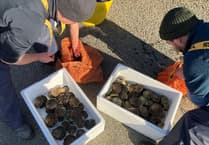Talk of taking sand from around Tenby’s harbour and North Beach areas to replenish parts of the South Beach could be problematic as Pembrokeshire County Council have an obligation not to interfere with natural processes, a meeting heard last week.
Despite suggestions that sand dredged from other areas of the resort’s beaches could be moved to the South Beach, which has experienced significant erosion in recent years, PCC’s Head of Environment and Civil Contingencies, Richard Brown, told those present at the meeting that he felt that such action could prove an issue with the Natural Resources Wales (NRW) authority.
Warning signs were recently placed on the resort’s South Beach by PCC, informing visitors to watch out for exposed power cables and other trip hazards which have become prominent due to the erosion on the once ‘golden sands’ which now shows a surface of rocks and pebbles.
Tenby town councillor Paul Rapi recently described the popular beach as a scene of ‘devastation’ calling for an urgent plan of action as he had never known it as being so ‘doom and gloomy’ in that area.
PCC’s coastal engineer, Emyr Williams, who recently said in an interview that he believed the sand would return to the South Beach by the summer, told the meeting that sand on the nearby Castle Beach was currently at ‘unprecedented levels’, but that this was due to natural action.
He noted that he had seen sand levels drop on Castle Beach as much as 10ft in one storm, only for it to rise 6ft again over the next few days.
Mr. Williams felt that care was needed in using datum on current high levels of sand to justify any work carried out because of changing climatic conditions.
He was of the opinion that the case to Natural Resources Wales may benefit from suggestions to put the sand back on South Beach rather than offshore from dredging.
County councillor for Tenby’s North ward, Michael Williams, pointed out that a recent survey for his PhD by Tony Thomas had shown the topography of the sand had changed due to climatic conditions and that Tenby was not the only place experiencing this situation.
Clr. Rapi reiterated that the situation at the South Beach had been made worse by the removal of the groynes and felt that they should be put back.
Mr. Williams remarked that the tidal action on the South Beach had been affected ever since the Ritec had been culverted for the railway line in the 1850s, and that the sea was still trying to fill the estuary (as it had done historically when boats were able to reach St. Florence) and by time, the groynes were removed because they were unsafe, and were actually being sidestepped by the action of the sea.
Discussing the recent ‘land based’ dredge around the harbour area, Clr. Rapi felt that it had slightly improved the situation, but that the machines, tractors and trailers involved were not enough.
Tenby harbourmaster, Chris Salisbury, said that 1,500 tons of sand had been moved, which was the maximum allowed by NRW.
Discussion took place over the higher levels of sand around the lifeboat station than in the past and against the pier wall. Opinion was expressed that the sand levels meant that wave action broke higher against the pier wall increasing potential for damage during severe storms.
Mr. Williams stated that the higher sand level along the outer pier was actually protecting the wall which historically had undertaken some damage and if this sand were to be removed, then it could lead to more serious damage, as the power from the waves during storms would hit the wall directly, rather than the sand absorbing some of the tidal power.
Angus Dunlop, chair of the Tenby Harbour Users Association, felt a marine dredge outside the Harbour would return the area to the situation before the land dredging had stopped.
He stressed that a land dredge was required every year to ‘keep the wolf from the door’, but a marine dredge needed every three years to reduce sand coming into the harbour environs.
Mr. Williams said that there was a need to maintain a usable harbour and a baseline would establish what was needed to be done to maintain a two-and-a-half hour window either side of a neap tide.
It was agreed that as a starting point, a new survey should be commissioned to look at the situation from Giltar Point to First Point down to low water spring tide.
This would give a base, said Clr. Williams, to make a financial argument for capital funding for a marine dredge.
The meeting concluded that a survey would help inform future discussions with NRW but, while a capital bid for a one-off marine dredge may be possible, a three-yearly dredge would have revenue implications.
However, climate change mitigation grants may also assist and these could be explored.




